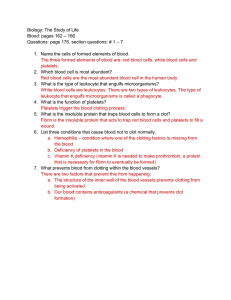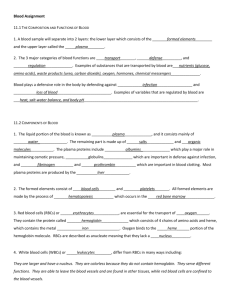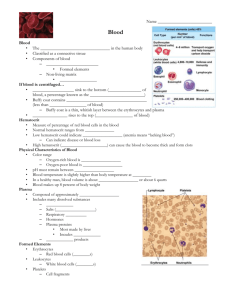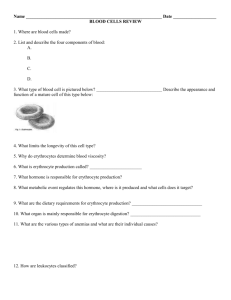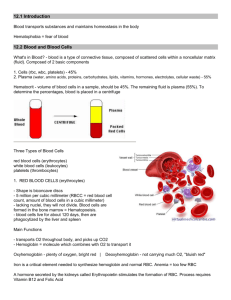Blood
advertisement
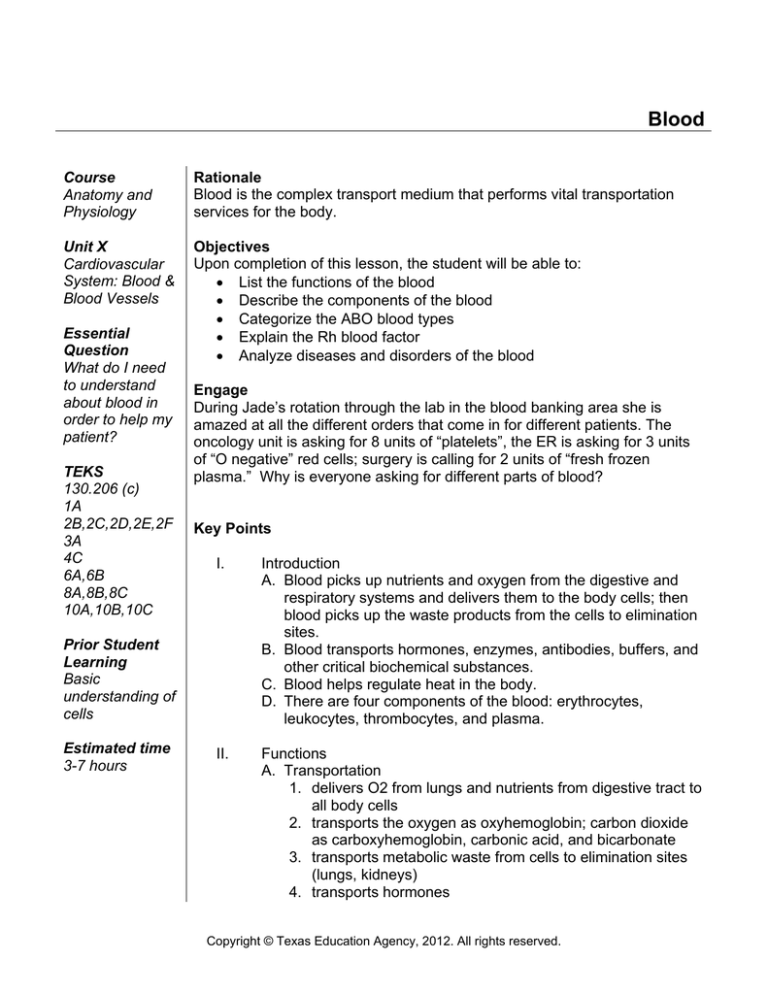
Blood Course Anatomy and Physiology Rationale Blood is the complex transport medium that performs vital transportation services for the body. Unit X Cardiovascular System: Blood & Blood Vessels Objectives Upon completion of this lesson, the student will be able to: • List the functions of the blood • Describe the components of the blood • Categorize the ABO blood types • Explain the Rh blood factor • Analyze diseases and disorders of the blood Essential Question What do I need to understand about blood in order to help my patient? TEKS 130.206 (c) 1A 2B,2C,2D,2E,2F 3A 4C 6A,6B 8A,8B,8C 10A,10B,10C Engage During Jade’s rotation through the lab in the blood banking area she is amazed at all the different orders that come in for different patients. The oncology unit is asking for 8 units of “platelets”, the ER is asking for 3 units of “O negative” red cells; surgery is calling for 2 units of “fresh frozen plasma.” Why is everyone asking for different parts of blood? Key Points I. Introduction A. Blood picks up nutrients and oxygen from the digestive and respiratory systems and delivers them to the body cells; then blood picks up the waste products from the cells to elimination sites. B. Blood transports hormones, enzymes, antibodies, buffers, and other critical biochemical substances. C. Blood helps regulate heat in the body. D. There are four components of the blood: erythrocytes, leukocytes, thrombocytes, and plasma. II. Functions A. Transportation 1. delivers O2 from lungs and nutrients from digestive tract to all body cells 2. transports the oxygen as oxyhemoglobin; carbon dioxide as carboxyhemoglobin, carbonic acid, and bicarbonate 3. transports metabolic waste from cells to elimination sites (lungs, kidneys) 4. transports hormones Prior Student Learning Basic understanding of cells Estimated time 3-7 hours Copyright © Texas Education Agency, 2012. All rights reserved. B. Regulation 1. maintains appropriate body temperature 2. maintains normal pH 3. maintains adequate fluid volume with NaCl and other salts acting with blood proteins (albumin) to prevent excessive fluid loss C. Protection 1. prevents blood loss through clotting mechanism 2. prevents infection through immunity (phagocytosis and antibody production) III. General Characteristics of Blood A. Formed elements: living blood cells 1. 2 out of 3 are NOT true cells 2. most short lived 3. most do not divide 4. hematopoiesis occurs in liver, spleen, thymus, and bone marrow 5. erythrocytes a. 45% (hematocrit) b. RBC’s transport oxygen 6. leukocytes and platelets a. <1% b. buffy coat B. Plasma - fluid matrix with fibrous proteins (fibrin) C. Physical characteristics 1. viscous 2. pH 7.35-7.45 3. temperature: 38 o C or 100.4 o F 4. 7%-8% of total body weight 5. males: 5-6 liters 6. females: 4-5 liters IV. Plasma - the fluid portion of blood consisting mostly of water; carries dissolved substances such as electrolytes, hormones, gases, and organic compounds. A. 90% - 92% water B. Straw colored sticky fluid C. 8% proteins 1. albumin (60%) 2. globulins (36%): alpha, beta, gamma (antibodies) 3. clotting proteins: fibrinogen, prothrombin 4. others: metabolic enzymes, antibacterial proteins, hormones Erythrocytes (RBCs) A. mature erythrocyte is an anucleated biconcave disc V. Copyright © Texas Education Agency, 2012. All rights reserved. approximately 7 mm in diameter B. the most numerous of all formed elements C produced from the bones in the red bone marrow D. at maturity, the erythrocyte does not contain ribosomes, mitochondria, or other organelles found in most body cells; this is to make room for the principle pigment -- hemoglobin E. the advantage of the biconcave disk shape is the cell can move without injury through the narrow blood capillaries F. hemoglobin -- principle pigment of the erythrocyte 1. composed of four protein chains called globin; each contains a red pigment called heme, which is composed of an iron atom 2. heme transports oxygen while globin transports carbon dioxide 3. it is estimated each erythrocyte contains 200 to 300 million molecules of hemoglobin VI. Leukocytes: White Blood Cells A. Description 1. leukocytes are nucleated cells capable of dividing and living for years 2. larger than erythrocytes 3. help protect the body from infection and provide immunity 4. 5,000-10,000 leukocytes per cubic millimeter; produced in the red bone marrow of bones 5. five types of leukocytes B. Types of Leukocytes 1. Granulocytes -- these leukocytes have protein granules in their cytoplasm; there are three specific types: a. Neutrophils have cytoplasmic granules which stain pink or light purple; most numerous of all leukocytes making up about 60% of the total count; nuclei are divided into two, three, or four lobes; neutrophils help protect the body by performing phagocytosis. b. Basophils have large cytoplasmic granules which stain dark blue or purple; cells very mobile and travel easily throughout the body; nuclei resemble S-shape These cells produce histamine (used in the inflammation response) and heparin (an anticoagulant used to prevent blood clotting). c. Eosinophils contain large cytoplasmic granules which stain reddish orange; nuclei contain two lobes and resemble head phones. Eosinophils ingest inflammatory chemicals and proteins and help to protect against allergens. C. Agranulocytes -- these leukocytes do not have large Copyright © Texas Education Agency, 2012. All rights reserved. granules in the cytoplasm. There are two specific types: 1. Monocytes are the largest of all leukocytes, with dark kidney bean shaped nuclei surrounded by large amounts of a distinctive light bluish gray cytoplasm. These cells are very mobile and protect the body by performing phagocytosis. 2. Lymphocytes are the smallest of all leukocytes. They have large spherical nuclei surrounded by a limited amount of pale blue stained cytoplasm. The lymphocytes will specialize into T-lymphocytes (T-cells) and B-lymphocytes (B-cells); T-cells are responsible for directly attacking antigens or infected cells while B-cells produce antibodies. VII. Thrombocytes are the platelets or plts; they assist in hemostasis and blood clotting. A. Description -- hemostasis refers to stopping bleeding which is extremely important when the blood vessels are damaged in order to prevent excessive blood loss. These mechanisms are most effective in slowing down blood losses from smaller blood vessels. Damage to larger vessels will require additional interventions to slow down and stop the bleeding. There are three stages including vascular spasm, platelet plug formation, and coagulation. B. Three Stages: 1. vascular spasm -- occurs when an arteriole or venule is broken or has been cut. The smooth muscles in the blood vessel wall are stimulated to contract and the blood loss is decreased almost immediately. The reflex response may last only a few minutes, but the effect will last for around 30 minutes. Serotonin, a chemical released by the platelets, also stimulates the blood vessel walls to contract. 2. platelet plug formation - platelets tend to stick to the exposed ends (collagen) of injured blood vessels. Actually, platelets stick to any rough surface which makes internal blood clotting possible. When the platelets come into contact with the collagen, their shapes actually change and many spiny processes begin to extend from their membranes. At the same time, the platelets stick to each other to form a platelet plug in the blood vessel break. 3. coagulation a. coagulation is the actual formation of a blood clot, and is the most effective of all of the hemostatic mechanisms. Copyright © Texas Education Agency, 2012. All rights reserved. b. There are two mechanisms associated with blood clotting -- the intrinsic mechanism and the extrinsic mechanism. The intrinsic mechanism is triggered by the release of chemical substances from the platelets while the extrinsic mechanism is triggered by the release of chemical substances released from the damaged blood vessels and tissues. VIII. Accessory Components A. Bone Marrow 1. manufactures RBCs, WBCs, and platelets 2. iliac crest and sternum preferred site for biopsy (bone marrow aspiration) B. Spleen 1. provides reservoir for blood cells 2. active in destroying bacteria in the blood 3. found in LUQ behind and below the stomach C. Liver 1. produces plasma proteins, heparin, antibodies 2. serves as a filter for blood D. Kidneys 1. filters blood and excretes waste as urine 2. produces erythropoietin E. Blood Types There are four blood types -- A, B, AB, and O. Blood types are based on the type of antigen or protein located on the surface of the erythrocyte membranes. Each blood type also has an antibody found in the blood plasma which attaches to a specific antigen and destroys them. Copyright © Texas Education Agency, 2012. All rights reserved. The Rh factor refers to the presence or absence of protein D on the surface of the erythrocyte membranes. Rh + refers to the presence of protein D on the surface of the erythrocyte membrane. Rh- refers to the absence of protein D on the surface of the erythrocyte membrane. IX. Diseases and Disorders of Blood A. Anemia -- deficiency in the numbers of functional RBCs; symptoms = dyspnea, fatigue, muscle weakness B. Polycythemia Vera - too many RBCs and platelets; thickens blood and increases BP; periodic removal of a unit of blood to thin the blood C. Leukemia -- Increased number of WBCs but they are nonfunctional. WBCs take over RBCs; therefore there are not enough RBCs to circulate oxygen. S & S: fever, joint pains, swollen lymph nodes, anemia D. Thrombocytopenia purpura - Decrease in production of platelets in the bone marrow E. Hemophilia -- X-linked recessive bleeding disorder of males Females are the carriers -- Clotting factor deficiencies F. Von Willebrand’s Disease -- Hereditary bleeding disorder of males and females; clotting factor deficiency G. Embolism -- moving blood clot that becomes trapped in small vessels or capillaries and obstructs oxygen to that part H. Thrombosis -- stationary blood clot in a larger vessel that obstructs the vessel I. Infectious Mononucleosis -- caused by the Epstein-Barr virus. Causes increased number of atypical lymphocytes. S & S: fever, sore throat, enlarged spleen, enlarged lymph nodes, headache, malaise J. Multiple Myeloma - Plasmacytoma infiltrates bone to produce osteolytic lesions, bone marrow failure, and renal failure. S & S: bone pain, hypercalcemia K. Hodgkin’s disease - Macrophages increase in size and number replace lymphocytes. Lymphoma begins in one node, usually cervical, and spreads. More common in men. S & S: recent URI, night sweats, anorexia, N&V, cough, dyspnea, nephralgia. L. Erythroblastosis Fetalis -- Antigen-antibody reaction due to mixing of Rh+ blood of fetus with Rh- blood of mother during a second Rh+ pregnancy. Can be prevented with shot of Rhogam at birth of first Rh+ baby M. AIDS -- Acquired immune deficiency syndrome 1. Defect in T-cell immunity caused by the HIV virus (human immunodeficiency virus) 2. Opportunistic infections: Pneumocystic pneumonia, Copyright © Texas Education Agency, 2012. All rights reserved. Kaposi’s sarcoma (vascular tumors) 3. ELISA test: enzyme-linked immunosorbent assay; detects antibody to the AIDS virus 4. Western blot test: more sophisticated, more specific, more expensive; used to confirm positive ELISA test Activity I. Complete Blood Worksheet II. Complete Simulated Blood Typing activity III. Research and report on advances in stem cells such as cord blood utilization and report findings Assessment Blood Test Writing Rubric Materials Blood Worksheet Blood Typing Kits from Carolina Biologicals, Ward, Pocket Nurse, etc. Computer access for students Guest Speakers: Hematologist, Blood Bank Specialist or Representative Utah State Office of Education, (2005). Medical Anatomy and Physiology Teacher Resource CD. Utah. Accommodations for Learning Differences For reinforcement, the student will develop flashcards of the key terms. For enrichment, students will research and report on advances in bioengineering and transplant technology. National and State Education Standards National Health Science Cluster Standards HLC01.01 Academic Foundations Health care workers will know the academic subject matter required (in addition to state high school graduation requirements) for proficiency within their area. They will use this knowledge as needed in their role. HLC1O.01 Technical Skills Health Care Workers will apply technical skills required for all career specialties. They will demonstrate skills and knowledge as appropriate. TEKS 130.206 (c)(1)(A) demonstrate safe practices during laboratory and field investigations; 130.206 (c)(2)(A) know the definition of science and understand that it has limitations, as specified in subsection (b)(2) of this section; Copyright © Texas Education Agency, 2012. All rights reserved. 130.206 (c)(2)(B) know that hypotheses are tentative and testable statements that must be capable of being supported, or not supported, by observational evidence. Hypotheses of durable explanatory power which have been tested over a wide variety of conditions are incorporated into theories; 130.206 (c)(2)(C) know scientific theories are based on natural and physical phenomena and are capable of being tested by multiple independent researchers. Unlike hypotheses, scientific theories are well-established and highly-reliable explanations, but they may be subject to change as new areas of science and new technologies are developed; 130.206 (c)(2)(D) distinguish between scientific hypotheses and scientific theories; 130.206 (c)(2)(E) plan and implement descriptive, comparative, and experimental investigations, including asking questions, formulating testable hypotheses, and selecting equipment and technology; 130.206 (c)(2)(F) collect and organize qualitative and quantitative data and make measurements with accuracy and precision using tools such as calculators, spreadsheet software, data-collecting probes, computers, standard laboratory glassware, microscopes, various prepared slides, stereoscopes, metric rulers, electronic balances, hand lenses, Celsius thermometers, hot plates, lab notebooks or journals, timing devices, Petri dishes, lab incubators, dissection equipment, meter sticks, and models, diagrams, or samples of biological specimens or structures; 130.206 (c)(3)(A) in all fields of science, analyze, evaluate, and critique scientific explanations by using empirical evidence, logical reasoning, and experimental and observational testing, including examining all sides of scientific evidence of those scientific explanations, so as to encourage critical thinking by the student; 130.206 (c)(4)(C) analyze the effects of energy deficiencies in malabsorption disorders such as diabetes, hypothyroidism, and Crohn's disease; 130.206 (c)(6)(A) investigate and describe the integration of the chemical and physical processes, including equilibrium, temperature, pH balance, chemical reactions, passive transport, active transport, and biofeedback, that contribute to homeostasis; 130.206 (c)(6)(B) determine the consequences of the failure to maintain homeostasis; 130.206 (c)(8)(A) analyze the physical, chemical, and biological properties of transport systems, including circulatory, respiratory, and excretory; 130.206 (c)(8)(B) determine the factors that alter the normal functions of transport systems; 130.206 (c)(8)(C) contrast the interactions among the transport systems; 130.206 (c)(10)(A) analyze the relationships between the anatomical structures and physiological functions of systems, including the integumentary, nervous, skeletal, musculoskeletal, cardiovascular, respiratory, gastrointestinal, endocrine, and reproductive; Copyright © Texas Education Agency, 2012. All rights reserved. 130.206 (c)(10)(B) evaluate the cause and effect of disease, trauma, and congenital defects on the structure and function of cells, tissues, organs, and systems; 130.206 (c)(10)(C) research technological advances and limitations in the treatment of system disorders. Texas College and Career Readiness Standards English Language Arts II. B. Understand new vocabulary and concepts and use them accurately in reading, writing, and speaking. III. B. Develop effective speaking styles for both group and one-on-one situations. IV. A. Apply listening skills as an individual, and as a member of a group in a variety of settings. IV. B. 2. Listen actively and effectively in one-on-one communication situations. Science 1. A.1. Utilize skepticism, logic, and professional ethics in science. 1. A.2. Use creativity and insight to recognize and describe patterns in natural phenomenon. 1. A.3. Formulate appropriate questions to test understanding of a natural phenomenon. 1. A.4. Rely on reproducible observations of empirical evidence when constructing, analyzing, and evaluating explanations of natural events and processes. 1. E.2. Use essential vocabulary of the discipline being studied. 3. A.1. Use correct applications of writing practices in scientific communication. Copyright © Texas Education Agency, 2012. All rights reserved. The Blood 1. List and describe the four components of blood. a. b. c. d. 2. Describe the appearance of a mature erythrocyte. 3. What two parts make up a hemoglobin molecule? a. b. 4. How are leukocytes classified? 5. What term refers to the stoppage of bleeding? 6. List and describe the three steps associated with blood clotting. a. b. c. 7. What is the basic event in the creation of a blood clot? 8. A ________________________ is a stationary blood clot while a is a traveling clot. Copyright © Texas Education Agency, 2012. All rights reserved. 9. Complete the following chart on blood types. 10. What might be indicated by an excess of white blood cells in the blood? 11. What problems might you have if you had no platelets in your blood? 12. What does Rh positive mean? 13. Type AB blood has often been called the universal recipient meaning a person with this blood type could receive a transfusion of any other blood type. Explain why this phrase is misleading. ("Medical anatomy and," 2005) Copyright © Texas Education Agency, 2012. All rights reserved. Key - The Blood 1. List and describe the four components of blood. a. Plasma - the fluid portion of blood b. Erythrocytes - the red blood cells used to carry oxygen and carbon dioxide c. Leukocytes - the white blood cells used to fight infection d. Thrombocytes - the platelets used to clot blood 2. Describe the appearance of a mature erythrocyte. A mature red blood cell looks like a biconcave disk. This is because it no longer has many of the normal cellular organelles such as a nucleus is order to make room for the hemoglobin molecule which is vital in transporting oxygen (and a little carbon dioxide). 3. What two parts make up a hemoglobin molecule? a. Heme b. Globin 4. How are leukocytes classified? As granulocytes or as agranulocytes, depending on whether or not there are granules in the cytoplasm. 5. What term refers to the stoppage of bleeding? Hemostasis 6. List and describe the three steps associated with blood clotting. a. Vascular Spasm This phase occurs when the arteriole or venule has been cut or broken and the smooth muscles contract in order to slow down or stop the flow of blood. b. Platelet Plug Formation This phase occurs when platelets stick to the exposed ends of the injured blood vessels. c. Coagulation This is when the blood clot is actually formed. Due to the presence of calcium, blood clotting factors, and enzymes, a plasma protein, fibrinogen, is changed to fibrin. Fibrin forms actual fibers which hold the ends of the damaged blood vessels together forming a mass known as a clot. 7. What is the basic event in the creation of a blood clot? The conversion of the plasma protein fibrinogen to fibrin. 8. A thrombus is a stationary blood clot while an embolus is a traveling clot. Copyright © Texas Education Agency, 2012. All rights reserved. 9. Complete the following chart on blood types. 10. What might be indicated by an excess of white blood cells in the blood? Infection or cancer of the blood (leukemia) 11. What problems might you have if you had no platelets in your blood? Your blood would not be able to clot. 12. What does Rh positive mean? The person’s red blood cells have an additional antigen (protein D). 13. Type AB blood has often been called the universal recipient meaning a person with this blood type could receive a transfusion of any other blood type. Explain why this phrase is misleading. Giving the person Type A, Type B, or Type O blood would introduce antibodies into this person’s blood and a blood reaction could occur. ("Medical anatomy and," 2005) Copyright © Texas Education Agency, 2012. All rights reserved. Blood Unit Test Multiple Choice. Choose the best answer. _____1. What is the average normal pH of blood? a. 8.4 b. 7.8 c. 7.4 d. 4.7 _____2. Which of the following is a regulatory function of blood? a. delivery of oxygen to body cells b. transport of metabolic wastes from cells c. maintenance of normal pH in body tissues d. prevention of blood loss _____3. Which of the following is a protective function of blood? a. maintenance of normal pH in body tissues b. maintenance of adequate fluid volume c. prevention of blood loss d. maintenance of body temperature _____4. Which of the following is a function of blood? a. transport metabolic wastes to the cells of the body b. maintain the proper body temperature c. protect the body against hormones d. eliminate the buffy coat from leukocytes _____5. The normal range of blood volume for males is a. 5 – 6 milliliters b. 4 – 5 liters c. 5 – 6 cups d. 5 – 6 liters _____6. The molecule in RBCs used to transport O2 and CO2 is a. hemoglobin b. cholesterol c. calcium oxalate d. folic acid _____7. The hormone that stimulates RBC production is a. testosterone b. erythropoietin c. estrogen d. thyroxin Copyright © Texas Education Agency, 2012. All rights reserved. _____8. The oxygen deprivation that stimulates the kidneys to increase production of the hormone that stimulates RBC production is called a. hyperoxia b. hyperglycemia c. hypoxia d. hyperventilation _____9. The “RBC graveyard” is the a. thyroid gland b. pancreas c. spleen d. gallbladder _____10. Which of the following might trigger erythropoiesis? a. decreased tissue demand for oxygen b. increased tissue demand for oxygen c. an increased number of RBCs d. moving from a high altitude to a low altitude _____11. All of the following can be expected with polycythemia except: a. low blood viscosity b. high hematocrit c. increased blood volume d. high blood pressure _____12. Aplastic anemia is caused by a. blood loss b. lysing of RBCs prematurely c. destruction or inhibition of hematopoietic components in red marrow d. lack of B12 _____13. Blood doping is a. a cancer of the bone marrow b. a type of anemia c. a contagious infection of RBCs d. secondary polycythemia _____14. The process of WBCs slipping out of the capillaries into mainly loose CT is called a. thrombocytopenia b. diapedesis c. leukopenia d. leukocytosis Copyright © Texas Education Agency, 2012. All rights reserved. _____15. The condition in which there is a WBC count greater than 11,000 WBCs per cubic millimeter (an indication of infection) is called a. leukocytosis b. diapedesis c. leukopenia d. thrombocytopenia _____16. Which of the following is a characteristic of all leukocytes? a. They are phagocytic. b. They have cytoplasmic granules. c. They are nucleated. d. They are the most numerous of the formed elements of the blood. _____17. A differential cell count that shows an increase in the percentage of eosinophils present indicates a: a. bacterial infection b. parasitic infection or allergies c. viral infection d. chronic infection _____18. A differential cell count that shows an increase in the percentage of lymphocytes indicates a a. bacterial infection b. parasitic infection or allergies c. viral infection d. chronic infection _____19. A differential cell count which shows an increase in the percentage of neutrophils indicates a: a. bacterial infection b. parasitic infection or allergies c. viral infection d. chronic infection _____20. Select the term that does NOT belong in the following group. a. erythrocyte b. lymphocyte c. monocyte d. eosinophil _____21. Select the term that does NOT belong in the following group. a. neutrophil b. monocyte c. basophil d. eosinophil Copyright © Texas Education Agency, 2012. All rights reserved. _____22. What element of nutrition is necessary for the formation of the complex protein which carries O2 in the RBC? a. Fe b. Ca++ c. Na++ d. Mg++ _____23. Fragments of a megakaryocyte are called a. basophils b. platelets c. erythrocytes d. monocytes _____24. Platelets: a. stick to the damaged area of a blood vessel and help seal the break b. have a life span of 120 days c. are the precursors of leukocytes d. have multiple nuclei _____25. A clot that develops and persists in an unbroken blood vessel is called a. embolus b. infarct c. lack of Factor VIII d. thrombus _____26. A decrease in the number of platelets is called a. leukocytosis b. thrombocytopenia c. leukopenia d. anemia _____27. The sex-linked bleeding disorder is called a. anemia b. thrombocytopenia c. hemophilia d. leukemia _____28. Which blood type is the universal donor? a. A b. B c. AB d. O Copyright © Texas Education Agency, 2012. All rights reserved. _____29. Which blood type is the universal recipient? a. A b. B c. AB d. O _____30. Mr. Smith’s blood was determined to be AB positive. What does this mean? a. Antibodies to A and B are present in the red cells. b. There are no antibodies to A, B, or Rh antigens in the plasma. c. His blood lacks the Rh factor. d. All of the above are correct. _____31. An individual who is blood type AB negative a. can receive any blood type in moderate amounts except that with the Rh antigen b. can donate to all blood types in moderate amounts c. can receive types A, B, and AB but not type O d. can donate to types A, B, and AB but not type O _____32. When can erythroblastosis fetalis not possibly happen in the child of an Rh negative mother? a. if the child is type O positive b. if the child is Rh positive c. if the father is Rh positive d. if the father is Rh negative Extra Credit 1. Explain why blood is classified as a connective tissue. (1 point) 2. What determines whether blood is bright red (scarlet) or dull brick-red (dark red)? (1 point) 3. Discuss the effect of a permanent move from sea level to a high-altitude area on RBC count. (2 points) 4. What is the normal (desirable) range for plasma cholesterol concentration (mg/100 ml)? Describe the relationship between high blood cholesterol levels and cardiovascular diseases such as hypertension, MLS, and strokes. (2 points) Copyright © Texas Education Agency, 2012. All rights reserved. Blood Unit Test Key Multiple Choice. Choose the best answer. C 1. What is the average normal pH of blood? a 8.4 b. 7.8 c. 7.4 d. 4.7 C 2. Which of the following is a regulatory function of blood? a. delivery of oxygen to body cells b. transport of metabolic wastes from cells c. maintenance of normal pH in body tissues d. prevention of blood loss C 3. Which of the following is a protective function of blood? a. maintenance of normal pH in body tissues b. maintenance of adequate fluid volume c. prevention of blood loss d. maintenance of body temperature B 4. Which of the following is a function of blood? a. transport metabolic wastes to the cells of the body b. maintain the proper body temperature c. protect the body against hormones d. eliminate the buffy coat from leukocytes D 5. The normal range of blood volume for males is a. 5 – 6 milliliters b. 4 – 5 liters c. 5 – 6 cups d. 5 – 6 liters A 6. The molecule in RBCs used to transport O2 and CO2 is a. hemoglobin b. cholesterol c. calcium oxalate d. folic acid B 7. The hormone that stimulates RBC production is a. testosterone b. erythropoietin c. estrogen d. thyroxin Copyright © Texas Education Agency, 2012. All rights reserved. A 8. The oxygen deprivation that stimulates the kidneys to increase production of hormone that stimulates RBC production is called a. hyperoxia b. hyperglycemia c. hypoxia d. hyperventilation C 9. The “RBC graveyard” is the a. thyroid gland b. pancreas c. spleen d. gallbladder B 10. Which of the following might trigger erythropoiesis? a. decreased tissue demand for oxygen b. increased tissue demand for oxygen c. an increased number of RBCs d. moving from a high altitude to a low altitude A 11. All of the following can be expected with polycythemia except: a. low blood viscosity b. high hematocrit c. increased blood volume d. high blood pressure C 12. Aplastic anemia is caused by a. blood loss b. lysing of RBCs prematurely c. destruction or inhibition of hematopoietic components in red marrow d. lack of B12 D 13. Blood doping is a. a cancer of the bone marrow b. a type of anemia c. a contagious infection of RBCs d. secondary polycythemia D 14. The process of WBCs slipping out of the capillaries into mainly loose CT is called a. thrombocytopenia b. diapedesis c. leukopenia d. leukocytosis e. Copyright © Texas Education Agency, 2012. All rights reserved. A 15. The condition in which there is a WBC count greater than 11,000 WBCs per cubic millimeter (an indication of infection) is called a. leukocytosis b. diapedesis c. leukopenia d. thrombocytopenia C 16. Which of the following is a characteristic of all leukocytes? a. They are phagocytic. b. They have cytoplasmic granules. c. They are nucleated. d. They are the most numerous of the formed elements of the blood. B 17. A differential cell count that shows an increase in the percentage of eosinophils present indicates a: a. bacterial infection b. parasitic infection or allergies c. viral infection d. chronic infection C 18. A differential cell count that shows an increase in the percentage of lymphocytes indicates a a. bacterial infection b. parasitic infection or allergies c. viral infection d. chronic infection A 19. A differential cell count which shows an increase in the percentage of neutrophils indicates a: a. bacterial infection b. parasitic infection or allergies c. viral infection d. chronic infection A 20. Select the term that does NOT belong in the following group. a. erythrocyte b. lymphocyte c. monocyte d. eosinophil B 21. Select the term that does NOT belong in the following group. a. neutrophil b. monocyte c. basophil d. eosinophil Copyright © Texas Education Agency, 2012. All rights reserved. A 22. What element of nutrition is necessary for the formation of the complex protein which carries O2 in the RBC? a. Fe b. Ca++ c. Na++ d. Mg++ B 23. Fragments of a megakaryocyte are called a. basophils b. platelets c. erythrocytes d. monocytes A 24. Platelets: a. stick to the damaged area of a blood vessel and help seal the break b. have a life span of 120 days c. are the precursors of leukocytes d. have multiple nuclei D 25. A clot that develops and persists in an unbroken blood vessel is called a. embolus b. infarct c. lack of Factor VIII d. thrombus B 26. A decrease in the number of platelets is called a. leukocytosis b. thrombocytopenia c. leukopenia d. anemia C 27. The sex-linked bleeding disorder is called a. anemia b. thrombocytopenia c. hemophilia d. leukemia D 28. Which blood type is the universal donor? a. A b. B c. AB d. O Copyright © Texas Education Agency, 2012. All rights reserved. C 29. Which blood type is the universal recipient? a. A b. B c. AB d. O A 30. Mr. Smith’s blood was determined to be AB positive. What does this a. Antibodies to A and B are present in the red cells. b. There are no antibodies to A, B, or Rh antigens in the plasma. c. His blood lacks the Rh factor. d. All of the above are correct. A 31. An individual who is blood type AB negative a. can receive any blood type in moderate amounts except that with the Rh antigen b. can donate to all blood types in moderate amounts c. can receive types A, B, and AB but not type O d. can donate to types A, B, and AB but not type O D 32. When can erythroblastosis fetalis not possibly happen in the child of an Rh negative mother? a. if the child is type O positive b. if the child is Rh positive c. if the father is Rh positive d. if the father is Rh negative mean? Extra Credit.. 1. Explain why blood is classified as a connective tissue. (1 point) 2. What determines whether blood is bright red (scarlet) or dull brick-red (dark red)? (1 point) 3. Discuss the effect of a permanent move from sea level to a high-altitude area on RBC count. (2 points) 4. What is the normal (desirable) range for plasma cholesterol concentration (mg/100 ml)? Describe the relationship between high blood cholesterol levels and cardiovascular diseases such as hypertension, MIs, and strokes. (2 points) Copyright © Texas Education Agency, 2012. All rights reserved. Writing Rubric Student: ________________________________ Scoring criteria 4 Excellent Date: ___________________ 3 Good 2 Needs Some Improvement 1 Needs Much N/A Improvement The writing has all required parts from introduction to conclusion in smooth transition. The writing is interesting, supportive, and complete. The writing demonstrates that the writer comprehends the writing process. Accurate spelling, grammar, punctuation. Content of paragraphs emphasizes appropriate points. The writer shows an understanding of sentence structure, paragraphing, and punctuation. All sources and references are clearly and accurately documented. NOTE: N/A represents a response to the performance which is "not appropriate." Copyright © Texas Education Agency, 2012. All rights reserved.


